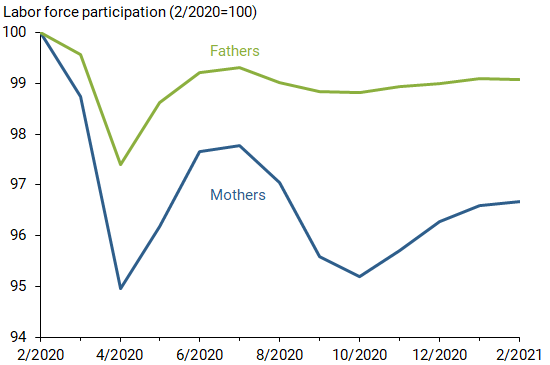COVID-19 disrupted all aspects of life. Mandated restrictions and individual decisions made to limit the spread of the virus changed patterns of people’s daily activity. The ensuing impact on economic activity led to steep declines in labor force participation across genders, races, and ethnic groups.
Mothers experienced sharper and longer-lasting declines than fathers. Moreover, the participation rates for Black mothers and Hispanic mothers were among the most negatively affected by the pandemic.
Comparing participation losses for mothers versus fathers
In a recent working paper, we examine changes in labor force participation rates by gender, parental status, and race during the pandemic, using detailed microdata on prime-aged workers from the Current Population Survey. Figure 1 shows the participation rates for mothers and fathers, normalized to 100 in February 2020, and the changes to each after the onset of the pandemic in the United States.
Figure 1. Labor force participation for parents during COVID-19

As the figure shows, both mothers and fathers experienced big drops in labor force participation in April 2020, with the decline among mothers twice as pronounced as that for fathers. Parents’ labor force participation rates recovered significantly during the summer months. But by October, mothers’ labor force participation dropped back to the previous April low. Furthermore, in spite of recovering steadily since November, their participation rate still remains well below its pre-pandemic level.
The challenges for working mothers across race and ethnicity
While mothers as a group fared worse than fathers, their experiences varied widely according to race and ethnicity. This is in line with studies showing that racially and ethnically underrepresented groups suffer more in severe recessions (Aaronson et al. 2019), and the pandemic recession is no exception.
Figure 2 distinguishes the changes in labor force participation rates for Black mothers (red line), Hispanic mothers (blue line), and white mothers (green line). Between February and April 2020, participation rates fell two times as much for Black mothers and Hispanic mothers, relative to white mothers. Furthermore, the robust job recovery for Black mothers and Hispanic mothers during the summer months was all but undone with the start of the school year.
Figure 2. Disparities in pandemic participation rates among mothers

Although there are signs of a modest recovery among Black mothers and Hispanic mothers, their level of participation in the labor market in February 2021 was around 5% below their pre-pandemic level of participation.
Balancing home work and paid work
One defining aspect of work during the pandemic has been the ability, or lack thereof, to shoulder childcare responsibilities and paid employment.
With schools either closed or in some mode of remote learning, parents have been required to shift some of their time to supervising more of their children’s education. This responsibility has fallen mostly to mothers (Zamarro and Prados 2021).
Our research uncovered smaller job loss for mothers with flexible work schedules. These schedule adjustments allow mothers greater ability to take care of children while continuing to be part of the labor force. This highlights the importance of supporting broad and reliable access to childcare to ensure a full and equitable recovery in the labor market.
Read the full paper: Parents in a Pandemic Labor Market
Olivia Lofton is a research associate in the Economic Research Department of the Federal Reserve Bank of San Francisco.
Nicolas Petrosky-Nadeau is a vice president in the Economic Research Department of the Federal Reserve Bank of San Francisco.
Lily Seitelman is a research associate in the Economic Research Department of the Federal Reserve Bank of San Francisco.
Photo credit: CarmenMurillo via iStock
You may also be interested in:
The views expressed here do not necessarily reflect the views of the management of the Federal Reserve Bank of San Francisco or of the Board of Governors of the Federal Reserve System.
